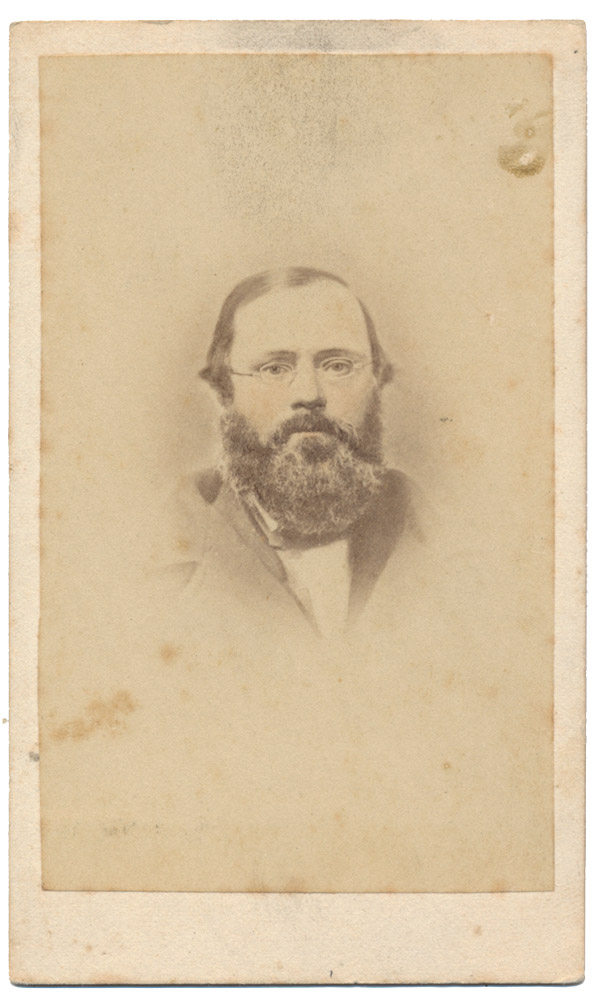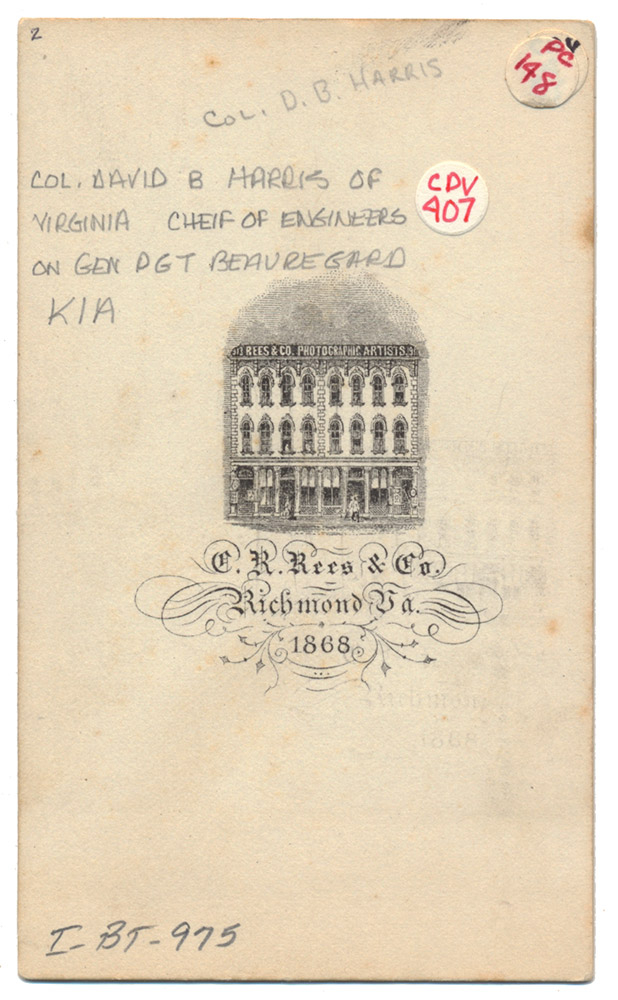site search
online catalog
DATED CDV OF CONFEDERATE ENGINEER COLONEL DAVID B. HARRIS BY REES OF RICHMOND

Hover to zoom


$950.00
Quantity Available: 1
Item Code: 1138-975
Shipping: Determined by Method & Location of buyer
To Order:
Call 717-334-0347,
Fax 717-334-5016, or E-mail
Image is a straight-on bust view of Harris in a light-colored civilian suit with a dark fold down collar.
Contrast and clarity are excellent. Mount is good but the paper has light scattered foxing along the edges and in the lower left and upper right corners.
Reverse has a photographer’s imprint for C. R. REES…RICHMOND, VA. 1868. ID is done in modern pencil along with some collector information.
Since Harris died in 1864 this image was obviously made from an earlier negative.
Image is from the collection of the late William A. Turner.
David Bullock Harris was born at Frederick's Hall (now spelled Fredericks Hall) in Louisa County, Virginia, on September 28, 1814, and grew up at Gardner's Crossroads in Louisa County.
Harris graduated from the United States Military Academy in 1833 and served for two years in the artillery and as an engineering instructor at the U.S. Military Academy. He resigned from the Army as a second lieutenant in 1835. For two years, he worked as an engineer for the James River and Kanawha Canal Company. Thereafter, he did railroad survey work. By 1845, he had acquired "Woodville", a Goochland County plantation, where he was a tobacco farmer and where he resided at the outbreak of the Civil War.
Harris was appointed a captain of engineers in the Virginia militia on May 2, 1861. By July, he was serving on the staff of Confederate Army Brigadier General Philip St. George Cocke. He was engaged at the First Battle of Bull Run on July 21, 1861 and was afterwards assigned to the staff of General P. G. T. Beauregard.
Harris planned Confederate defenses of Centreville, Virginia; Fort Pillow; Island Number Ten; Vicksburg, Mississippi; and Charleston, South Carolina. He was promoted to captain of Confederate engineers on February 15, 1862, to major on October 3, 1862, to lieutenant colonel on May 5, 1863, and to colonel on October 8, 1863. After Beauregard took command at Charleston for the second time, Harris worked constantly to improve the fortifications, often visiting troops in exposed and dangerous positions to design improvements. These defenses proved too formidable for besieging Union forces to overcome. After traveling with Beauregard to Virginia, where he planned defenses at Petersburg in the summer of 1864, Harris returned to Charleston and the post of chief engineer of the Department of South Carolina. He soon died of yellow fever though at Summerville, South Carolina, on October 10, 1864, having just turned 50.
Harris had been recommended for promotion to brigadier general, and Confederate President Jefferson Davis verbally promised the promotion to him shortly before Harris died. The promotion had not gone through before Harris died, though some early lists of Confederate generals showed Harris as a brigadier.
David Bullock Harris is buried in Hollywood Cemetery, Richmond, Virginia. [ad] [ph:L]
~~~~~~~~~~~~~~~~~~~~~~~~~~~~~~~~~~~
THIS ITEM, AS WITH ALL OTHER ITEMS AVAILABLE ON OUR WEB SITE,
MAY BE PURCHASED THROUGH OUR LAYAWAY PROGRAM.
CLICK HERE FOR OUR POLICIES AND TERMS.
THANK YOU!
Inquire About DATED CDV OF CONFEDERATE ENGINEER COLONEL DAVID B. HARRIS BY REES OF RICHMOND
Most Popular
Historical Firearms Stolen From The National Civil War Museum In Harrisburg, Pa »
Theft From Gravesite Of Gen. John Reynolds »
Selection Of Unframed Prints By Don Troiani »
Fine Condition Brass Infantry Bugle Insignia »
Large English Bowie Knife With Sheath 1870’S – 1880’S »
Imported (Clauberg) Us Model 1860 Light Cavalry Officer's Saber »
featured item
IDENTIFIED CONFEDERATE 1/6 PLATE AMBROTYPE, J.H. DOYLE, 7TH S.C. CAVALRY
This ambrotype photograph features young James Hogan [Hagan] Doyle posing in plain uniform coat with hands across his waist. Three plain buttons are visible on his jacket which also has a standing collar. Image is clear with Doyle’s cheeks lightly… (141-190). Learn More »


